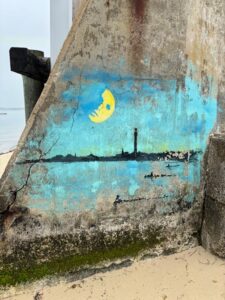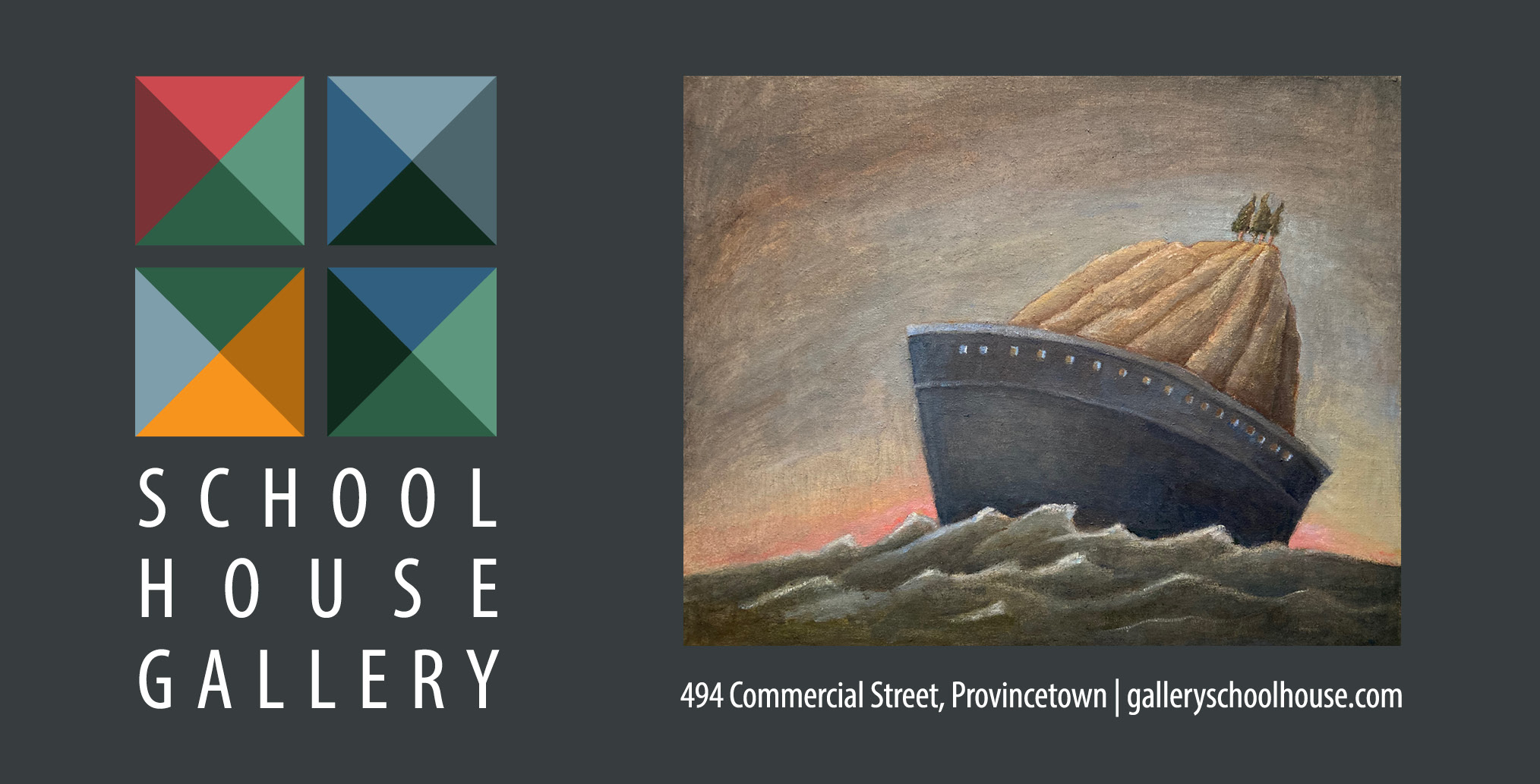It has been two years since I discovered David Read’s painting on a seawall in the East End of town (“Painting on the Seawall,” June 29, 2023). That amounts to hundreds of days and nights and high tides, and numerous storms: wind, waves, and sand blasting the painted surface.
This morning, I stood before it for a prolonged visit. I am perhaps as changed as it is, but we both have survived. The painting shows some areas of abrasion, rough patches of unadorned concrete partly plastered with eelgrass; its colors are somewhat muted; the fissures running through it have widened. Bright green algae at its base add a color that looks intended, and tiny barnacles also seem to belong.
The depicted scene — the waterfront, the spires of the library, town hall, the U.U. church, and the monument — is still discernible and probably will be for years to come. But it sets the tone of dissolution, of the temporary nature of all things under the Sun. The concrete seawall itself has a termination date, although no one can predict it with certainty. Surely it will crumble, probably incrementally or perhaps all at once, under the advance of waves. Or maybe it will just be submerged, little fishes inspecting the painted patterns with bewilderment, as plodding periwinkle snails crawl over its face.
When the seawall falls or goes under, the house behind it will be on borrowed time — a curious phrase. Borrowed from what? The past gives us the present, which borrows from the future. When the house and its neighbors go, so will the town, block by block, over the decades or perhaps a century or two. The streets will be tidal, the curbs integrated into sandbars. All our precious belongings will be flotsam and jetsam. People may visit the area but not be able to live here. Today I see workers with heavy machinery toiling on yet another bulkhead down the way, but their urgent work will in time lose all importance and be no more relevant than these words that are trying to describe it.
So, my inspection of the painted seawall concludes, and my solitary walk continues, but it fundamentally differs from two years ago. It is just one step after another, with no Dory by my side. My life has taken an unexpected turn, and I carry a broken heart. It is as real as any physical part of me. But I know that the fact that I have lost my dog is just one among the innumerable facts about me and will someday lose its emotional freight, just as we do not mourn the victims of ancient disasters or wars.
Still, there is a dull ache and a poverty of experience. And then there is the aging: time hangs heavy and inexorably chips away at the only life I will ever have. The years cannot be ignored as they take their toll. The simplest tasks complexify and take more out of me. In time, I will be increasingly unrecognizable, like the fissured wall. There will be a day when I will not be here. As the ranks thin at my men’s club — the latest, my dear friend Ken Oxtoby — I, too, will join the departed.
But the eternal present reigns supreme on this misty morning. A distant engine, the occasional resonant voice, and the song sparrow’s notes ride the still air. The lapping water indicates that it means no harm. Empty mollusk shells lie beneath the surface, slowly dissolving their calcium carbonate essence back into the water. Grackles patrol the tide line and hunt for snails on the rocky jetties. A cormorant rises in the still water with a wiggling little fish in its bill. We are all sometimes predators or prey — but mostly bystanders.
The natural world is not imbued with any meaning: we must bring meaning to it. Art also requires a response to make any sense. Slowly but surely, I make my way home. On the way, I meet a neighbor in her 90s; she looks about her and proclaims, “It’s not the same.”
I am not entirely sure what she is referring to, but I heartily agree.



